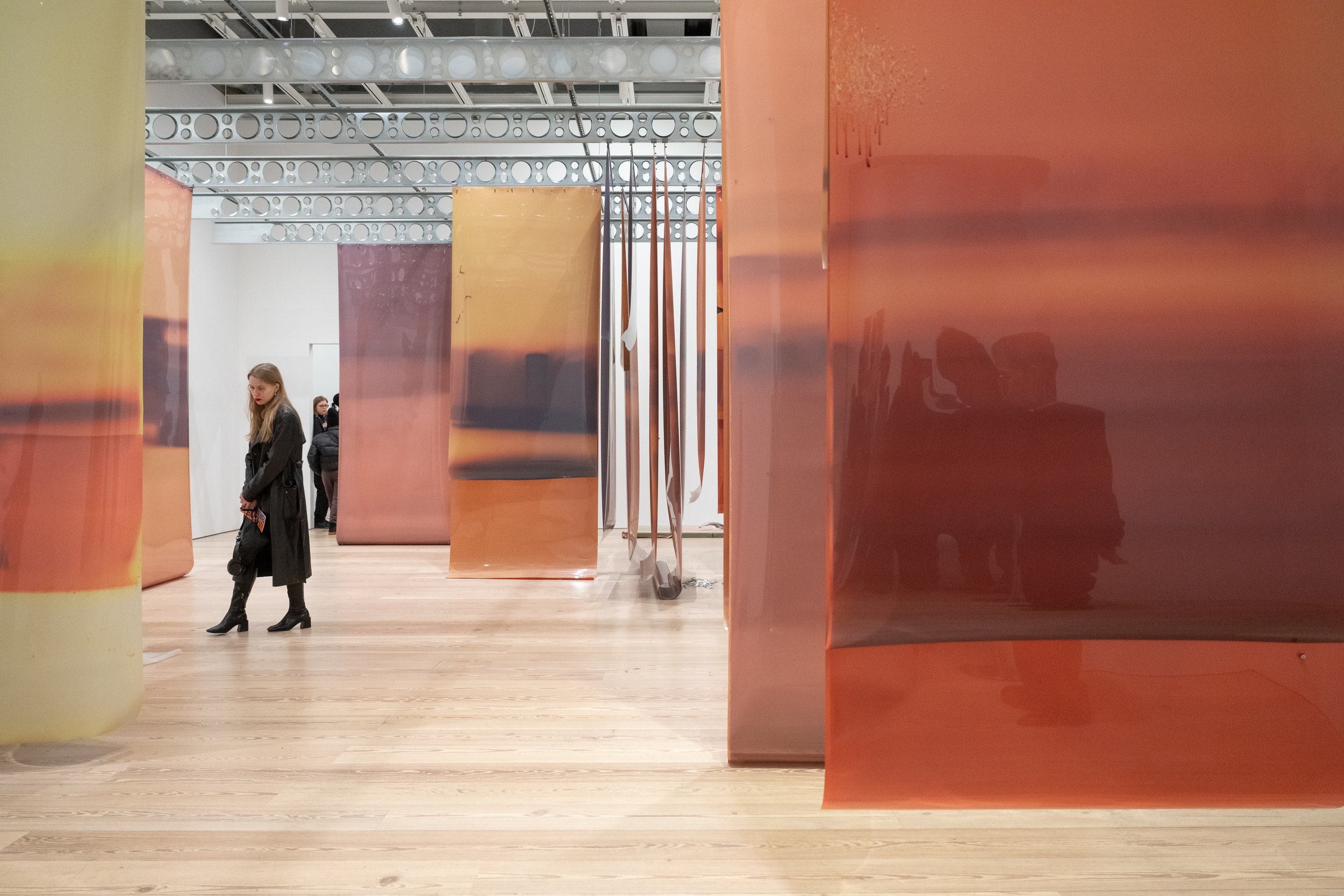
Photo Credit: Filip Wolak
Lotus L. Kang’s In Cascades
In a small room at the Whitney Biennial, Lotus L. Kang has laid out tatami mats for her installation In Cascades (2023-24). The tatamis instantly transport me back to the summers I spent as a child in my Pala’s home in exile. My sister and I would sleep side-by-side on tatamis on the floor. Despite the heat and humidity, we would wrap a thin sheet over our little bodies, creating our own ecosphere. We would tuck ourselves in from every side–making sure there were no gaps–so that the shiny dark cockroaches that came out at night wouldn’t crawl on us as we slept. I can sense the feeling of laying my body over the tightly woven rush grass of the tatami; the tactility of running my small fingers over the mat’s lightly ridged surface in the dark before I fell asleep.
Hanging above Kang’s tatamis are what most visitors at the Whitney notice first: large, industrial-sized sheets of photographic film that cascade down from metal beams. The sheets form the architecture for the installation, providing routes to navigate the space. They seem to float, swaying gently in dialogue with the movement of the bodies of the visitors.
The film strips, rendered in tones of tan and brown, hang like strips of skin or intestines. In Traditional Chinese Medicine, the skin and intestines are two parts of a whole. Representing the inside and outside expanses of the human structure, they form the Möbius strip of the body: a single permeable and absorptive surface, vulnerable and porous to its surroundings and the beings it shares space with. Accordingly, the chemistry of Kang’s film strips is alive, a digestive organ onto itself that is constantly morphing according to its natural life cycle. The large-scale backlit photographic film is unfixed. Kang brings the film, meant to be used in controlled environments, out of the darkroom and into the space of the gallery, allowing it to be in dialogue with the body. Kang refers to the exposure as a “tanning,” evoking the idea of the film as a flesh. The sheets are affected by the light and atmospheric conditions of the spaces they travel to, accumulating a dense and ever-expanding archive of their movements.
Photo Credit: Charlie Ruben
“At its essence, a photograph is a pursuit to make the transitory permanent.”
The film strips are distinctly anti-photographic. At its essence, a photograph is a pursuit to make the transitory permanent. With photography, a cursory moment that exists within the tempo of human-time is distorted and locked into a fixed simulacrum. Kang’s use of photographic materials releases any grip onto the idea of a faithful or stable image, reconfiguring them to the rhythm of temporality.
Paradoxically, it is not the photographs, but the sculptural elements of Kang’s installation that provide the most visceral space for images. Across the tatami mats, Kang has laid out sculptural elements that suggest ancestral lineage, decay, and diasporic migration. On one mat lies a skin-like silicone sheet rendered in a delicate peachy tone. Another is adorned with cabbage leaves and oranges wrapped in crumpled translucent tissue to form a makeshift altar. This one in particular brings me back to Pala’s where, in the mornings, we would fold up our sleeping mats, and use them as makeshift tables as we sat on the floor enjoying a breakfast of light-coloured broths and ripe, juicy fruits with bright and colourful peels. All of a sudden, I can see my Pala unwrapping an orange, piling its peel neatly on the tatami as he sits cross-legged across from me, telling stories and folk tales of a land he can no longer return to.
Photo Credit: Dzifah Danso
Tatamis serve as temporary, “good-enough” resting spaces. Lightweight and portable, they provide sites of rest for the body of the nomad, the displaced or the guest: they are the territory of those in liminal, unfixed space. In the world Kang creates, nothing is permanent or separate; rather, each element points to the interconnection and mutability of matter. Refuting any illusions of permanence or stability, each element in In Cascades points to the temporal. Ever-changing and continually in flux, Kang aligns the work with the alchemy of existence.
On a last tatami, Kang lays down lotus roots, which carry the symbolism of rites and ritual, but are also of the body: used as medicine by our ancestors, and in cooking and as snacks at diasporic gatherings. The plant’s rhizomes are cast out of metal–the element associated with grief and sorrow in Traditional Chinese Medicine–and are laid out to form an arch. The shape, reminiscent of a river or a spinous process, bends and flows organically across the surface of the mat. Like skeletal remains, their structure is distinctly corporal.



